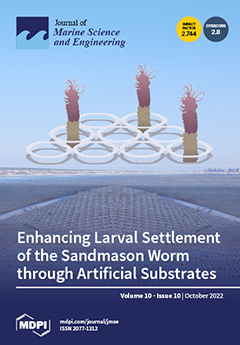The distributions of artificial radionuclides, radiocesium (
134Cs and
137Cs) and plutonium isotopes (
238Pu and
239+240Pu), in the surface water around the Korean seas (East/Japan Sea and Yellow Sea) in 2011–2012 and in three sections in the North
[...] Read more.
The distributions of artificial radionuclides, radiocesium (
134Cs and
137Cs) and plutonium isotopes (
238Pu and
239+240Pu), in the surface water around the Korean seas (East/Japan Sea and Yellow Sea) in 2011–2012 and in three sections in the North Pacific between 2011 and 2014 were examined. The
137Cs activities in the surface water in the Korean seas in 2011 (immediately after the Fukushima nuclear power plant (NPP) accident on 17 March 2011) were comparable or not significantly different relative to those in 2010 and 2012. However,
134Cs, which had been not detected in the study area before the Fukushima accident (under the detection limit of 0.1 mBq kg
−1 level), were detected rapidly in 2011 after the accident (in about 60% of the 72 samples) and gradually disappeared due to their short half-life (t
1/2 = 2.06 years) in 2012 (detected in about 16% of the 24 samples). In addition, the highest activities of radiocesium and Pu isotopes appeared locally in some stations of the Korean Strait region (located between Korea and Japan) within 1–2 months immediately after the accident. This suggests that the radioactive nuclides released immediately after the Fukushima accident were significantly introduced through the atmosphere, based on recent studies conducted in neighboring areas. We also showed that the spatial distribution of radiocesium in the North Pacific moved eastward from 2012 to 2014, and we attempted to quantify the residence time of radiocesium (
137Cs) in the Korean seas based on the long-term (tens of years scale) temporal trends of
137Cs activity data, which have been collected since the 1960s and 1970s. The estimated retention time of
137Cs in the East/Japan Sea and Yellow Sea were 25 ± 0.6 and 8.0 ± 0.1 years, respectively. These results are expected to be used as a preliminary study for a potential future event of a marine radioactive accident (which, of course, cannot be predicted) and as basic data for predicting the influences of radionuclide releases in the ocean.
Full article





